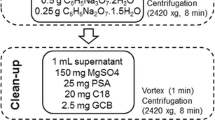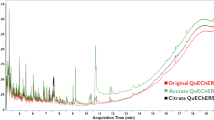Abstract
In this study, a simple and high-throughput multiresidue pesticide analysis method based on the quick, easy, cheap, effective, rugged, safe (QuEChERS) extraction combined with gas chromatography-triple quadrupole mass spectrometry (GC-MS/MS) and ultra-high performance liquid chromatography coupled to tandem mass spectrometry (UHPLC-MS/MS) is presented for the determination of 113 pesticides in green and ripe mangoes. Different buffer systems and purification sorbents were optimized to get better recovery. Extracts from mangoes after acid acetonitrile and ammonium acetate extraction were directly injected to UHPLC-MS/MS analysis, whereas other GC-amenable compounds were treated with cleanup approaches with a mixture of sorbents [400 mg primary-secondary amine (PSA) and 400 mg graphitized carbon black (GCB)] for GC-MS/MS analysis. Recoveries for the majority of pesticides at spike levels of 10, 50, and 100 μg/kg were ranged between 70 and 120% with RSD values below 20%. Limits of detection (LODs) were below 4 μg/kg, whereas limits of quantification (LOQs) were below 10 μg/kg. Response linearity was good in the range between 5 and 500 μg/kg. The matrix effect for 56 pesticides by GC-MS/MS analysis exhibited a non-significant matrix effect (≤ 25%) in green and ripe mangoes. For 57 pesticides used for UHPLC-MS/MS analysis, the optimized method in green mango provided no significant matrix effect (≤ 25%) for 63% of the compounds, whereas only for 16 and 21% compounds, the matrix effect was medium (25–40%) and strong (> 40%); the optimized method in ripe mango provided no significant matrix effect (≤ 25%) for 61% of the compounds, whereas only for 26 and 12% compounds, the matrix effect was medium (25–40%) and strong (> 40%). Following the application of a “top-down” approach, the expanded measurement uncertainty was both 21% on average (coverage factor k = 2, confidence level 95%) in green and ripe mangoes. The application of GC-MS/MS and UHPLC-MS/MS coupled with the modified QuEChERS extraction procedures was proved to adequately quantitate these pesticides in different maturity levels of mangoes.






Similar content being viewed by others
References
Amvrazi EG, Albanis TA (2006) Multiresidue method for determination of 35 pesticides in virgin olive oil by using liquid-liquid extraction techniques coupled with solid-phase extraction clean up and gas chromatography with nitrogen phosphorus detection and electron capture detection. J Agric Food Chem 54(26):9642–9651
Anagnostopoulos CJ, Sarli PA, Liapis K, Haroutounian SA, Miliadis GE (2012) Validation of two variations of the QuEChERS method for the determination of multiclass pesticide residues in cereal-based infant foods by LC-MS/MS. Food Anal Methods 5(2):664–683
Anastassiades M, Lehotay SJ, Stajnbaher D, Schenck FJ (2003) Fast and easy multiresidue method employing acetonitrile extraction/partitioning and dispersive solid-phase extraction for the determination of pesticide residues in produce. J AOAC Int 86(2):412–431
Banerjee K, Oulkar DP, Patil SB, Jadhav MR, Dasgupta S, Patil SH, Bal S, Adsule PG (2009) Multiresidue determination and uncertainty analysis of 87 pesticides in mango by liquid chromatography-tandem mass spectrometry. J Agric Food Chem 57(10):4068–4078
Castillo MLR, Rodriguez-Valenciano M, Moreno FP, Blanch GP (2012) Evaluation of pesticide residue contents in fruit juice by solid-phase microextraction and multidimensional gas chromatography coupled with mass spectrometry. Talanta 89:77–83
China National food safety standard (2016) Maximum residue limits for pesticides in food. GB:2763–2016
Chamkasem N, Ollis LW, Harmon T, Lee S, Mercer G (2013) Analysis of 136 pesticides in avocado using a modified QuEChERS method with LC-MS/MS and GC-MS/MS. J Agric Food Chem 61:2315–2329
Cherta L, Beltran J, Pitarch E, Hernandez F (2013) Comparison of simple and rapid extraction procedures for the determination of pesticide residues in fruit juices by fast gas chromatography-mass spectrometry. Food Anal Methods 6(6):1671–1684
Chu XG, Hu XZ, Yao HY (2005) Determination of 266 pesticide residues in apple juice by matrix solid-phase dispersion and gas chromatography-mass selective detection. J Chromatogr A 1063(1-2):201–210
Deme P, Upadhyayula VVR (2015) Ultra performance liquid chromatography atmospheric pressure photoionization high resolution mass spectrometric method for determination of multiclass pesticide residuesin grape and mango juices. Food Chem 173:1142–1149
EC Council Directive 2002/657/EC (2002) Implementing council directive 96/23/EC concerning the performance of analytical methods and the interpretation of results.
Filho AM, Santos FN, Pereira PAP (2010) Development, validation and application of a methodology based on solid-phase microextraction followed by gas chromatography coupled to mass spectrometry (SPME/GC-MS) for the determination of pesticide residues in mangoes. Talanta 81:346–354
Food and Agriculture Organization of the United Nations (2013) Food and agricultural commodities production. < http://faostat.fao.org/site/339/default.aspx> 16.05.14.
Frenich AG, Vidal JLM, Pastor-Montoro E, Romero-Gonzalez R (2008) High-throughput determination of pesticide residues in food commodities by use of ultra-performance liquid chromatography-tandem mass spectrometry. Anal Bioanal Chem 390:947–959
Furlani RPZ, Marcilio KM, Leme FM, Tfouni SAV (2011) Analysis of pesticide residues in sugarcane juice using QuEChERS sample preparation and gas chromatography with electron capture detection. Food Chem 126(3):35–1287
Hayward DG, Wong JW, Shi F, Zhang K, Lee NS, Dibenedetto AL, Hengel MJ (2013) Multiresidue pesticide analysis of botanical dietary supplements using salt-out acetonitrile extraction, solid-phase extraction cleanup column, and gas chromatography-triple quadrupole mass spectrometry. Anal Chem 85:4686–4693
He ZY, Wang L, Peng Y, Luo M, Wang WW, Liu XW (2015) Multiresidue analysis of over 200 pesticides in cereals using a QuEChERS and gas chromatography-tandem mass spectrometry-based method. Food Chem 41:372–380
Jin BH, Xie LQ, Guo YF, Pang GF (2012) Multi-residue detection of pesticides in juice and fruit wine: a review of extraction and detection methods. Food Res Int 46(1):399–409
Koesukwiwat U, Lehotay SJ, Leepipatpiboon N (2011) Fast, low-pressure gas chromatography triple quadrupole tandem mass spectrometry for analysis of 150 pesticide residues in fruits and vegetables. J Chromatogr A 1218(39):7039–7050
Kwon H, Lehotay SJ, Geis-Asteggiante L (2012) Variability of matrix effects in liquid and gas chromatography-mass spectrometry analysis of pesticide residues after QuEChERS sample preparation of different food crops. J Chromatogr A 1270:235–245
Li L, Li W, Ge J, Wu YJ, Jiang SR, Liu FM (2008) Use of graphitic carbon black and primary secondary amine for determination of 17 organophosphorus pesticide residues in spinach. J Sep Sci 31:3588–3594
Medina-Pastor P, Valverde A, Pihlstrom T, Masselter S, Gamon M, Mezcua M, Rodriguez-Torreblanca C, Fernandez-Alba AR (2011) Comparative study of the main top-down approaches for the estimation of measurement uncertainty in multiresidue analysis of pesticides in fruits and vegetables. J Agric Food Chem 55:7609–7619
Nannan P, Tielong W, Jieye H (2016) Method validation and dissipation kinetics of four herbicides in maize and soil using QuEChERS sample preparation and liquid chromatography tandem mass spectrometry. Food Chem 58:793–800
Navickiene S, Aquino A, Bezerra DSS (2010) A matrix solid-phase dispersion method for the extraction of seven pesticides from mango and papaya. J Chromatogr Sci 48(9):750–754
Nieto-Garcia AJ, Romero-Gonzalez R, Frenich AG (2015) Multi-pesticide residue analysis in nutraceuticals from grape seed extracts by gas chromatography coupled to triple quadrupole mass spectrometry. Food Control 47:63–380
Palenikova A, Martinez-Dominguez G, Arrebola FJ, Romero-Gonzalez R, Hrouzkova S, Frenich AG (2015) Multifamily determination of pesticide residues in soya-based nutraceutical products by GC/MS-MS. Food Chem 173:796–807
Prestes OD, Friggi CA, Adaime MB, Zanella R (2009) QuEChERS—a modern sample preparation method for pesticide multiresidue determination in food by chromatographic methods coupled to mass spectrometry. Quimica Nova 32:1620–1634
Qu LJ, Zhang H, Zhu JH, Yang GS, Aboul-Enein HY (2010) Rapid determination of organophosphorous pesticides in leeks by gas chromatography-triple quadrupole mass spectrometry. Food Chem 122(1):327–332
Rejczak T, Tuzimski T (2015a) A review of recent developments and trends in the QuEChERS sample preparation approach. Open Chem 13:980–1010
Rejczak T, Tuzimski T (2015b) Recent trends in sample preparation and liquid chromatography/mass spectrometry for pesticide residue analysis in food and related matrixes. J AOAC Int 98(5):1143–1162
Rejczak T, Tuzimski T (2016) Simple, cost-effective and sensitive liquid chromatography diode array detector method for simultaneous determination of eight sulfonylurea herbicides in soya milk samples. J Chromatogr A 78:56–65
Rejczak T, Tuzimski T (2017a) Method development for sulfonylurea herbicides analysis in rapeseed oil Samples by HPLC-DAD: comparison of zirconium-based sorbents and EMR-lipid for clean-up of QuEChERS Extract. Food Anal Methods 10:3666-3679
Rejczak T, Tuzimski T (2017b) QuEChERS-based extraction with dispersive solid phase extraction clean-up using PSA and ZrO2-based sorbents for determination of pesticides in bovine milk samples by HPLC-DAD. Food Chem 84:225–233
Rissato SR, Galhiane MS, Knoll FRN, Apon BM (2004) Supercritical fluid extraction for pesticide multiresidue analysis in honey: determination by gas chromatography with electron-capture and mass spectrometry detection. J Chromatogr A 1048(2):153–159
Rizzetti TM, Kemmerich M, Martins ML, Prestes OD, Adaime MB, Zanella R (2016) Optimization of a QuEChERS based method by means of central composite design for pesticide multiresidue determination in orange juice by UHPLC-MS/MS. Food Chem 196:25–33
SANTE (2015) Guidance document on analytical quality control and validation procedures for pesticide residues analysis in food and feed. SANTE/11945/2015 30 November-1 December 2015 rev. 0
Sivaperumal P, Salauddin A, Kumar AR, Santhosh K, Rupal T (2017) Determination of pesticide residues in mango matrices by ultra high-performance liquid chromatography coupled with quadrupole time-of-flight massspectrometry. Food Anal Methods 10:2346–2357
Slowik-Borowiec M, Szpyrka E, Walorczyk S (2015) Gas chromatographic determination of pesticide residues in white mustard. Food Chem 173:997–1005
Srivastava AK, Rai S, Srivastava MK, Lohani M, Mudiam MKR, Srivastava LP (2014) Determination of 17 organophosphate pesticide residues in mango by modified QuEChERS extraction method using GC-NPD/GC-MS and hazard index estimation in Lucknow, India. PLOS ONE 9(5):e96493. https://doi.org/10.1371/journal.pone.0096493
Stajnbaher D, Zupancic-Kralj L (2003) Multiresidue method for determination of 90 pesticides in fresh fruits and vegetables using solid-phase extraction and gas chromatography-mass spectrometry. J Chromatogr A 1015(1-2):185–198
Wong JW, Zhang K, Tech K, Hayward DG, Makovi CM, Krynitsky AJ, Schenck FJ, Banerjee K, Dasgupta S, Brown D (2010) Multiresidue pesticide analysis in fresh produce by capillary gas chromatography –mass spectrometry/selective ion monitoring (GC-MS/SIM) and –tandem mass spectrometry (GC-MS/MS). J Agric Food Chem 58(10):5868–5883
Walorczyk S (2014) Validation and use of a QuEChERS-based gas chromatographic-tandem mass spectrometric method for multiresidue pesticide analysis in blackcurrants including studies of matrix effects and estimation of measurement uncertainty. Talanta 120:106–113
Yang X, Zhang H, Liu Y, Wang J, Zhang YC, Dong AJ, Zhao HT, Sun CH, Cui J (2011) Multiresidue method for determination of 88 pesticides in berry fruits using solid-phase extraction and gas chromatography-massspectrometry: determination of 88 pesticides in berry using SPE and GC-MS. Food Chem 127(2):855–865
Zhao MA, Feng YN, Zhu YZ, Kim JH (2014) Multi-residue method for determination of 238 pesticides in Chinese cabbage and cucumber by liquid chromatography-tandem mass spectrometry: comparison of different purification procedures. J Agric Food Chem 62:11449–11456
Zhu YZ, Zhao MA, Feng YN, Kim JH (2014) Multiresidue method for the determination of 227 pesticides in hot pepper (Capsicum annuum L.) by liquid chromatography with tandem mass spectrometry. J Sep Sci 37(20):119–2954
Acknowledgements
This work was financially supported by the special fund of the Supervision Bureau of Quality and Safety on Agro-Products in the Ministry of Agriculture and Rural Affairs of China (GJFP201700402).
Author information
Authors and Affiliations
Corresponding author
Ethics declarations
Conflict of Interest
Pingping Li declares that she has no conflict of interest. Yun Duan declares that he has no conflict of interest. Huilin Ge declares that he has no conflict of interest. Yue Zhang declares that she has no conflict of interest. Xiaofang Wu declares that she has no conflict of interest.
Ethical Approval
This article does not contain any studies with human participants or animals performed by any of the authors.
Informed Consent
Informed consent is not applicable for this study.
Rights and permissions
About this article
Cite this article
Li, P., Duan, Y., Ge, H. et al. Multiresidue Analysis of 113 Pesticides in Different Maturity Levels of Mangoes Using an Optimized QuEChERS Method with GC-MS/MS and UHPLC-MS/MS. Food Anal. Methods 11, 2742–2757 (2018). https://doi.org/10.1007/s12161-018-1263-5
Received:
Accepted:
Published:
Issue Date:
DOI: https://doi.org/10.1007/s12161-018-1263-5




